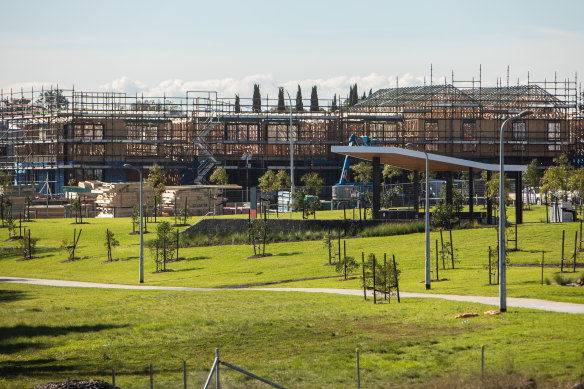This was published 1 year ago
New rules send ‘shock waves’ through the housing industry
Australia’s largest brickmaker says the extra expense of making homes more sustainable and a ban on engineered stone have sent shock waves through construction at a time when the growth in costs was easing.
Lengthy times for planning approvals and a lack of skilled labour are also weighing on the building industry, which is under intense pressure to increase much-needed supply.

Construction costs are weighing on the housing sector.Credit: Scott McNaughton
Lindsay Partridge, managing director of ASX-listed Brickworks, said building material costs were coming back to “reasonable” levels, but new state rules requiring new and renovated buildings to be more sustainable and climate resilient have added close to 10 per cent in extra costs.
Both the country’s most populous states have tweaked planning policies. The NSW government introduced sustainable building legislation in October this year targeting net-zero emissions by 2050, and, from January 2024, all new homes in Victoria will be banned from connecting to gas, requiring electric cooktops, heaters and water heaters instead.
“Costs were coming back to more reasonable levels, and then the [NSW] government changed the legislation regarding designs of houses and introduced a series of legislation on making them more sustainable. It has probably added $30,000 to $50,000 in costs to a house, which would be 10 per cent, at least,” Partridge said.
“It put shock waves through the housing industry.”
In mid-December, Australia became the first country in the world to ban engineered stone following a surge in workers developing the lung disease silicosis. The marble-like product is common in kitchen benches and bathroom vanities.
Partridge said the cost of switching to an alternative when building a new home or renovating would add substantially to construction costs.
He said, in general, there was evidence that the construction market would start picking up in Queensland because of immigration into the state. There is also strong demand in South Australia, where the state government has removed stamp duty for first-time owners.
Partridge said Victoria has a large pipeline of homes, but in NSW it takes up to nine months to get new home approvals, which could delay the industry’s recovery.
Carlos Cacho, chief economist at investment and advisory group Jarden, said despite strong underlying demand, “the biggest headwind to residential construction [is] affordability, with the combination of high interest rates and construction costs meaning new housing is unaffordable for most potential buyers”.
“We expect residential construction activity to slow materially next year, particularly as the current pipeline of work reaches completion around March 2024,” Cacho said.
Tarun Gupta, chief executive of Stockland, the country’s largest home builder, said the cost of goods has moderated from the highs of the past 12–18 months amid the global supply issues.
“From what we’re hearing from our major builder partners in NSW, the heat of the post-home buyer grant is subsiding,” Gupta said.
“Tradies are now looking for pipeline volumes of work, which leads to more stable and predictable pricing, which should indicate better news for consumers looking to build.”
“Pleasingly, our major builder partners in NSW are seeing building costs begin to stabilise,” he added.
“Items that did have substantial price increases, like bricks and tiling, are starting to stabilise, which is the result of some of the large state infrastructure projects coming to an end, and supply improving.”
The supply of skilled labour is still a challenge and is contributing to costs.
While construction cost inflation has eased, prices remain around 30 per cent higher than pre-pandemic levels, according to NAB’s economics division.
In its latest podcast series, the bank’s economists said that although supply chains continue to normalise, the large pipeline of work is still supporting demand for labour and materials. “Whether prices fully correct or remain high remains to be seen,” they said.
Property Council of Australia chief executive Mike Zorbas said the property industry remains broadly optimistic, “but inconsistent planning regimes and almost monthly tax hikes around the country are clouding the outlook”.
“While it is pleasing to see consistency of industry confidence, it is clear that housing supply and affordability continues to be a concern for industry experts – just as it will remain a decisive issue, alongside immigration, at the next federal election,” Zorbas said.
“Construction activity for the residential sector is below its historical average, and with the federal government targeting 1.2 million homes by 2029, we simply need to up our game on planning reform and housing delivery.”
The Business Briefing newsletter delivers major stories, exclusive coverage and expert opinion. Sign up to get it every weekday morning.